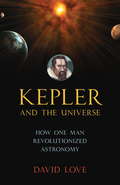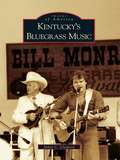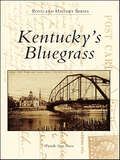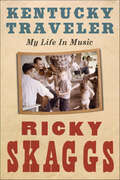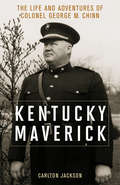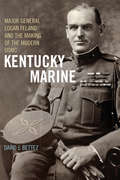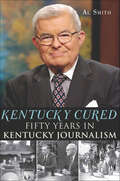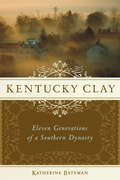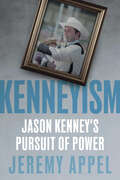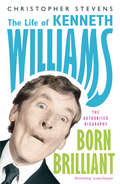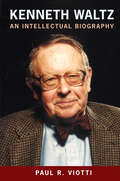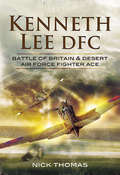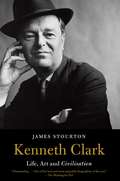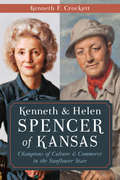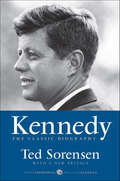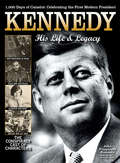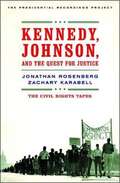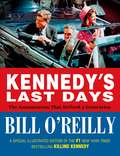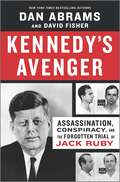- Table View
- List View
Kepler and the Universe
by David K. LoveA contemporary of Galileo and a forerunner of Isaac Newton, Johannes Kepler (1571-1630) was a pioneering German scientist and a pivotal figure in the history of astronomy. This colorful, well-researched biography brings the man and his scientific discoveries to life, showing how his contributions were every bit as important as those of Copernicus, Galileo, and Newton. It was Kepler who first advocated the completely new concept of a physical force emanating from the sun that controls the motion of the planets--today we call this gravity and take it for granted. He also established that the orbits of the planets were elliptical in shape and not circular. And his three laws of planetary motion are still used by contemporary astronomers and space scientists. The author focuses not just on these and other momentous breakthroughs but also on Kepler's arduous life, punctuated by frequent tragedy and hardships. His first wife died young, and eight of the twelve children he fathered succumbed to disease in infancy or childhood. He was frequently caught up in the religious persecutions of the day. His mother narrowly escaped death when she was accused of being a witch.Intermingling historical and personal details of Kepler's life with lucid explanations of his scientific research, this book presents a sympathetic portrait of the man and underscores the critical importance of Kepler's discoveries in the history of astronomy.From the Hardcover edition.
Kenzie's Rules for Life: How to Be Happy, Healthy, and Dance to Your Own Beat
by Maddie Ziegler Mackenzie ZieglerAn inspirational, upbeat collection of relatable lessons from the teen sensation, Mackenzie Ziegler—an award-winning dancer, singer/songwriter, and actress.Growing up is hard, but growing up in the spotlight is even harder. However, Mackenzie Ziegler is taking it all in stride, thanks to her positive attitude on life. From getting her start on Dance Moms, to her sold-out tour alongside Johnny Orlando, there’s nothing that she can’t do. In Kenzie’s Rules for Life, the dance prodigy, singer/songwriter, actress, and model offers her advice on friendship, family, fitness, style, and positivity. She shares lessons drawn from her own experiences for those navigating through their tween years on how to be happy, healthy, and confident in all aspects of their lives.
Kenzie's Rules For Life: How to be Healthy, Happy and Dance to your own Beat
by Mackenzie ZieglerAn inspirational, upbeat collection of relatable lessons from the teen sensation, Mackenzie Ziegler - an award-winning dancer, singer/songwriter and actress.Growing up is hard, but growing up in the spotlight is even harder. However, Mackenzie Ziegler is taking it all in stride, thanks to her positive attitude on life. From getting her start on Dance Moms, to her sold-out tour alongside Johnny Orlando, there’s nothing that she can’t do. In Kenzie’s Rules for Life, the dance prodigy, singer/songwriter, actress and model offers her advice on friendship, family, fitness, style and positivity. For anyone who enjoyed her sister’s Sunday Times bestselling book The Maddie Diaries, this will be the perfect accompaniment. She shares lessons drawn from her own experiences for those navigating through their tween years on how to be happy, healthy and confident in all aspects of their lives.
Kentucky's Bluegrass Music
by James C. ClaypoolIt is likely that most fans of bluegrass music would concede that no state should be more associated with bluegrass music than Kentucky--and rightly so. Bluegrass music draws its name from the band that Kentuckian Bill Monroe formed during the late 1930s and 1940s. Bill named his band Bill Monroe and The Blue Grass Boys to honor his home state. Eventually, the music these bands and others like them were playing came to be known as bluegrass music. Later, another Kentuckian, Ebo Walker, while playing with the Bowling Green-based bluegrass band, New Grass Revival, coined the phrase "newgrass" to describe the band's progressive style of music. Other Kentuckians such as Bobby and Sonny Osborne, J. D. Crowe, Ricky Skaggs, and Dale Ann Bradley have become bluegrass stars. Some of the musicians from Kentucky covered in this book are quite famous--some are not. Famous or not, all of them have a deep-rooted passion for the music they play.
Kentucky's Bluegrass (Postcard History Series)
by Wynelle Scott DeeseWithin these pages are vintage postcards, created between 1900 and 1950, that depict an area known across the country as Kentucky�s Bluegrass. From its horse farms to its military forts and river commerce, this seventeen county region exemplifies the spirit and pride of Kentucky, and the images preserved on these postcards bring the history of this unique area to life.
Kentucky Traveler: My Life in Music
by Ricky SkaggsIn Kentucky Traveler, Ricky Skaggs, the music legend who revived modern bluegrass music, gives a warm, honest, one-of-a-kind memoir of forty years in music—along with the Ten Commandments of Bluegrass, as handed down by Ricky’s mentor Bill Monroe; the Essential Guide to Bedrock Country Songs, a lovingly compiled walk through the songs that have moved Skaggs the most throughout his life; Songs the Lord Taught Us, a primer on Skaggs’s most essential gospel songs; and a bevy of personal snapshots of his musical heroes.For readers of Johnny Cash’s autobiography, lovers of O Brother Where Art Thou, and fans of country music and bluegrass, Kentucky Traveler is a priceless look at America’s most cherished and vibrant musical tradition through the eyes of someone who has lived it.
Kentucky Maverick: The Life and Adventures of Colonel George M. Chinn
by Carlton Jackson&“An absorbing story about how the Lincoln veteran George Watt managed to escape from Nazi-occupied Belgium.&”—San Francisco Review of Books November 1943: American flyer George Watt parachutes out of his burning warplane and lands in rural Nazi-occupied Belgium. Escape from Hitler&’s Europe is the incredible story of his getaway—how brave villagers spirited him to Brussels to connect with the Comet Line, a rescue arm of the Belgian resistance. This was a gravely dangerous mission, especially for a Jewish soldier who had fought against Franco in the Spanish Civil War. Watt recounts dodging the Gestapo, entering Paris via the underground, and finally, crossing the treacherous Pyrenees into Spain. In 1985, he returned to Belgium and discovered an astonishing postscript to his wartime experiences. &“A story of what is best in human beings triumphing over what is worst.&”—John Sayles, author of Yellow Earth &“One of those rare little narratives that engage the reader from the first page to the last . . . It is about the human spirit and those willing to risk their lives for a stranger.&”—Library Journal "A hell of an adventure story."―Ring Lardner, Jr., author of The Ecstasy of Owen Muir &“This is one of my favorite books about World War II, and the first I have read that is about the Comet Line and the people who helped with running it.&”—Armchair Interviews &“This is an interesting and exciting account that provides a first-person examination of the plight of an individual airman, and insights into the scope, risks, and techniques of the Belgian and French underground movements.&”—Col. Stetson M. Siler, USAF (Ret.)
Kentucky Marine: Major General Logan Feland and the Making of the Modern USMC
by David J. Bettez“Follows the changes in the Marine Corps from its role as colonial infantry to amphibious assault force . . . us[ing] the career of Maj. Gen. Logan Feland.” —Allan R. Millett, author of Semper FidelisWinner of the Marine Corps Heritage Foundation’s Colonel Joseph Alexander AwardA native of Hopkinsville, Kentucky, Major General Logan Feland (1869-1936) played a major role in the development of the modern Marine Corps. Highly decorated for his heroic actions during the battle of Belleau Wood in World War I, Feland led the hunt for rebel leader Augusto César Sandino during the Nicaraguan revolution from 1927 to 1929—an operation that helped to establish the Marines’ reputation in guerrilla warfare and search-and-capture missions. Yet, despite rising to become one of the USMC’s most highly ranked and regarded officers, Feland has been largely ignored in the historical record.In Kentucky Marine, David J. Bettez uncovers the forgotten story of this influential soldier of the sea. During Feland’s tenure as an officer, the Corps expanded exponentially in power and prestige. Not only did his command in Nicaragua set the stage for similar twenty-first-century operations in Iraq and Afghanistan, but Feland was one of the first instructors in the USMC’s Advanced Base Force, which served as the forerunner of the amphibious assault force mission the Marines adopted in World War II.Kentucky Marine also illuminates Feland’s private life, including his marriage to successful soprano singer and socialite Katherine Cordner Feland, and details his disappointment at being twice passed over for the position of commandant. Drawing from personal letters, contemporary news articles, official communications, and confidential correspondence, this long-overdue biography fills a significant gap in twentieth-century American military history.
Kentucky Cured: Fifty Years in Kentucky Journalism (American Chronicles)
by Al SmithAndrew Jackson fought a duel in rural Logan County, Kentucky. Jesse James robbed a bank there, and frontier lawyers began political careers. But a resentful Al Smith knew none of this when he got off the bus at Russellville, rented a room at a shabby hotel and asked for the nearest bootlegger. After losing two newspaper jobs in New Orleans, he was the new tramp editor of Russellville's little country weekly. He was thirty-one, and his life was in shambles. Fifty sober years later, his stories tell what happened after he was cured of his negative obsessions and discovered Kentucky was a land of the second chance. From county courthouse to the White House, read all about it.
Kentucky Clay: Eleven Generations of a Southern Dynasty
by Katherine BatemanEleven generations of a founding American family are examined in this sweeping history that traces the Clays of Kentucky, a true Southern dynasty. The Clays of Virginia and the Cecils of Maryland were second sons of the English aristocracy who gambled on the New World. Some of the most well-known members of this clan include Henry Clay, who ran for president against James K. Polk; his cousin, Cassius Marcellus Clay, prominent abolitionist and Lincoln's advisor against slavery; and the matriarch Kizzie Clay, who buried the family silver and escaped by flatboat to avoid marauding Union soldiers. The history of the early colonial period in America--from the time of their arrival in Jamestown, Virginia, in 1613 and St. Mary's, Maryland, in 1634 through the trek across Virginia to the Appalachian Mountains, their eventual intermarriage in 1800, and their move across the mountains to Kentucky--comes to life through this well-researched family saga that heralds the adventures and accomplishments of the men in the family, as well as reveals the stories and nontraditional roles of the strong, selfish, and headstrong women.
Kenneyism: Jason Kenney's Pursuit of Power
by Jeremy AppelThe harsh moralistic worldview of Jason Kenney has spurred right-wing populism to the mainstream in Canadian politics, but he unleashed forces he couldn’t control.From Jason Kenney’s days as an anti-abortion activist at the University of San Francisco, and through his years as a Canadian Taxpayers Federation lobbyist, Reform MP, top cabinet minister in the Harper government, and Alberta premier, he has been single-mindedly driven to bring his harsh moralistic worldview into the mainstream. Kenney took on the old guard of Canada’s liberal consensus and won, playing a key role in shifting the country’s political discussion to the right. But the very right-wing populist forces Kenney cultivated would come back to haunt him.Jeremy Appel has observed Alberta politics and reported on various aspects of Kenney’s agenda since 2017, when Kenney made his way across the province in his big blue pickup truck to rile up aggrieved conservatives. Kenneyism examines Kenney's political beliefs, his rise through federal political ranks, and his ultimate resignation from the leadership of the United Conservative Party.
Kenneth Williams: The Life of Kenneth Williams
by Christopher StevensKenneth Williams was the stand-out comic actor of his generation. Beloved as the manic star of Carry On films and as a peerless raconteur on TV chat shows, he was also acclaimed for serious stage roles. Born Brilliant includes previously unseen material from Williams's candid daily journal and also draw on rare in-depth interviews with friends and colleagues. Since the publication of edited extracts from his diaries, much controversy has surrounded Williams's personal and professional lives. This biography traces the complex contradictions that characterised an extraordinary life and presents the first full portrait of a star who was born brilliant.
Kenneth Williams: Born Brilliant (ebook)
by Christopher StevensKenneth Williams was the stand-out comic actor of his generation. Beloved as the manic star of Carry On films and as a peerless raconteur on TV chat shows, he was also acclaimed for serious stage roles. Born Brilliant includes previously unseen material from Williams's candid daily journal and also draw on rare in-depth interviews with friends and colleagues. Since the publication of edited extracts from his diaries, much controversy has surrounded Williams's personal and professional lives. This biography traces the complex contradictions that characterised an extraordinary life and presents the first full portrait of a star who was born brilliant.
Kenneth Waltz: An Intellectual Biography
by Paul R. ViottiKenneth Waltz (1924–2013) is perhaps the most enduringly influential figure in international relations theory of the second half of the twentieth century. He is considered the father of the structural-realist or neorealist school, and his views on core questions, such as the causes of war and the structure of the international system, are foundational to the field today and likely will remain so for decades to come. Waltz’s writings on both theoretical and policy-related topics, from the balance of power to the spread of nuclear weapons, continue to fuel debate.This book is a groundbreaking intellectual biography of Kenneth Waltz, shedding new light on the development and significance of his key contributions. Paul R. Viotti draws on extensive, candid interviews with Waltz as well as Waltz’s personal files and archival research to provide a nuanced account of the great scholar’s life and thought. He traces the intellectual sources and personal experiences that shaped Waltz’s work, including an intense Lutheran upbringing; service in World War II and the Korean War; and the academic environments of Oberlin College, Columbia University, and the University of California, Berkeley. Viotti examines the key influences on Waltz’s major works, Man, the State, and War and Theory of International Politics, and analyzes their distinctive insights. Engaging with the views of Waltz’s critics and featuring reminiscences from his colleagues, this book is a compelling portrait of an intellectual titan.
Kenneth Lee DFC: Battle of Britain & Desert Air Force Fighter Ace
by Nick ThomasThe heroic life of the pilot who became an ace with one of the most successful fighter squadrons in the RAF and a captive in a notorious Nazi POW camp. Following training, Lee received his commission and was posted to 501 Squadron which was sent to support the Expeditionary Force in France, arriving on 10 May, only hours after the Blitzkrieg had been launched. Lee quickly opened his score, claiming several bombers during the first week of operations. Having been wounded when his Hurricane exploded following a dogfight, Lee was briefly rested but soon rejoined the Squadron before they moved to their first Battle of Britain base at Middle Wallop. Lee scored more damaged and destroyed enemy aircraft and by the end of July he was Mentioned in Dispatches. Lee was forced to take to his parachute for the second time, learning of the richly deserved award of his DFC while still recovering from his wounds. He later recalled how each of the Squadrons aces, even Ginger Lacey, had been shot down at least twice during that summer. Lee was later posted to 112 (Shark) Squadron, flying Curtis Kittyhawks on Fighter and Fighter-Bomber missions in North Africa and then to 260 Squadron which was heavily involved in the lead-up to the battle of El Alamein, seeking out and destroying enemy troop columns and fighting off the Luftwaffe which still had air superiority. In March 1943, 123 Squadron began Fighter-Bomber operations against Mediterranean targets. During one Lee was hit by AA and made a forced landing in an olive grove. He was captured and sent to Stalag Luft III just in time to play a key role in the Great Escape.
Kenneth Jernigan: The Master, The Mission, The Movement
by Kenneth JerniganCompiled writings of Dr. Kenneth Jernigan with editorial introduction and notes
Kenneth Clark: Life, Art and Civilisation
by James StourtonThe definitive biography of this brilliant polymath--director of the National Gallery, author, patron of the arts, social lion, and singular pioneer of television--that also tells the story of the arts in the twentieth century through his astonishing life. Kenneth Clark's thirteen-part 1969 television series, Civilisation, established him as a globally admired figure. Clark was prescient in making this series: the upheavals of the century, the Cold War among others, convinced him of the power of barbarism and the fragility of culture. He would burnish his image with two memoirs that artfully omitted the more complicated details of his life. Now, drawing on a vast, previously unseen archive, James Stourton reveals the formidable intellect and the private man behind the figure who effortlessly dominated the art world for more than half a century: his privileged upbringing, his interest in art history beginning at Oxford, his remarkable early successes. At 27 he was keeper of Western Art at the Ashmolean in Oxford and at 29, the youngest director of The National Gallery. During the war he arranged for its entire collection to be hidden in slate mines in Wales and organized packed concerts of classical music at the Gallery to keep up the spirits of Londoners during the bombing. WWII helped shape his belief that art should be brought to the widest audience, a social and moral position that would inform the rest of his career. Television became a means for this message when he was appointed the first chairman of the Independent Television Authority. Stourton reveals the tortuous state of his marriage during and after the war, his wife's alcoholism, and the aspects of his own nature that he worked to keep hidden. A superb work of biography, Kenneth Clark is a revelation of its remarkable subject.
Kenneth Clark: Life, Art and Civilisation
by James StourtonThe definitive biography of this brilliant polymath--director of the National Gallery, author, patron of the arts, social lion, and singular pioneer of television--that also tells the story of the arts in the twentieth century through his astonishing life. Kenneth Clark's thirteen-part 1969 television series, Civilisation, established him as a globally admired figure. Clark was prescient in making this series: the upheavals of the century, the Cold War among others, convinced him of the power of barbarism and the fragility of culture. He would burnish his image with two memoirs that artfully omitted the more complicated details of his life. Now, drawing on a vast, previously unseen archive, James Stourton reveals the formidable intellect and the private man behind the figure who effortlessly dominated the art world for more than half a century: his privileged upbringing, his interest in art history beginning at Oxford, his remarkable early successes. At 27 he was keeper of Western Art at the Ashmolean in Oxford and at 29, the youngest director of The National Gallery. During the war he arranged for its entire collection to be hidden in slate mines in Wales and organized packed concerts of classical music at the Gallery to keep up the spirits of Londoners during the bombing. WWII helped shape his belief that art should be brought to the widest audience, a social and moral position that would inform the rest of his career. Television became a means for this message when he was appointed the first chairman of the Independent Television Authority. Stourton reveals the tortuous state of his marriage during and after the war, his wife's alcoholism, and the aspects of his own nature that he worked to keep hidden. A superb work of biography, Kenneth Clark is a revelation of its remarkable subject.From the Hardcover edition.
Kenneth & Helen Spencer of Kansas: Champions of Culture & Commerce in the Sunflower State
by Kenneth F. CrockettBorn on opposite sides of the Kansas/Missouri border in 1902, Kenneth Aldred Spencer and his wife, Helen Foresman Spencer, were transformative figures in the Midwest during the twentieth century. Kenneth grew up in the small town of Pittsburg, Kansas, but by the 1950s, his innovation in the chemical and coal industries had earned him mention in "Forbes" magazine for his role as one of the nation's great industrialists. But it is the couple's remarkable philanthropic work that stands as their true legacy, preserved in places like the Kenneth Spencer Research Library and the Helen Foresman Spencer Museum of Art..
Kennedy: The Classic Biography
by Ted Sorensen“A brilliant and essential document about the man, the President, and his times. In all the millions of words which have been written about the martyred President, this book must remain unique. . . . It is John F. Kennedy’s life, his personality, his thinking which informed his action and that action itself described with honest and candor which illuminate and enliven the crowded pages of this book. Sorensen has managed to portray Kennedy in realistic human terms and not as the hero of a myth. . . . It is the richness of detail, anecdotes, incidents, conversations, descriptions rather than any gossip or startling revelations which gives the book its compelling readability.” — Los Angeles TimesThe classic, intimate, and #1 national bestselling biography of JFK by his great advisor Ted Sorensen.In January 1953, freshman senator John F. Kennedy of Massachusetts hired a twenty-four-year-old from Nebraska as his Number Two legislative assistant—on a trial basis. Despite the differences in their backgrounds, in the eleven years that followed Ted Sorensen became known as Kennedy's intellectual blood bank, top policy aide, and alter ego.Sorensen knew Kennedy the man, the senator, the candidate, and the president as no other associate did. From his role as a legislative assistant to Kennedy's death in 1963, Sorensen was with him during the key crises and turning points—including the spectacular race for the vice presidency at the 1956 convention, the launching of Kennedy's presidential candidacy, the TV debates with Nixon, and election night at Hyannis Port. The first appointment made by the new president was to name Ted Sorensen his Special Counsel.In Kennedy, Sorensen recounts failures as well as successes with surprising candor and objectivity. He reveals Kennedy's errors on the Bay of Pigs, and his attitudes toward the press, Congress, and the Joint Chiefs of Staff. Sorensen saw firsthand Kennedy's actions in the Cuban missile crisis, and the evolution of his beliefs on civil rights and arms control. First published in 1965 and reissued here with a new preface, Kennedy is an intimate biography of an extraordinary man, and one of the most important historical accounts of the twentieth century.
Kennedy: His Life and Legacy
by Ben NussbaumCommemorating the fiftieth anniversary of the untimely death of America's most popular president, Kennedy: His Life & Legacy is a candid look at the charisma and excitement that captured the nation during John F. Kennedy's one thousand days of Camelot. <P><P>Editor Ben Nussbaum has compiled a collection of riveting chapters that discuss the influence and money of the Kennedy clan, the politics and unique circumstances that led to JFK's election, his presidency, his family, and his assassination. The book convincingly debunks the major conspiracy theories that mushroomed on our nation's darkest day, when the much-loved young president was violently slain in the streets of Dallas, Texas. Concise and colorful, this 96-page book offers readers a snapshot of President John Fitzgerald Kennedy and a glimpse at what made Americans fall in love with the thirty-fifth president during a time not only of great population and economic growth but also of pressing international conflicts with Vietnam, the U.S.S.R., and Cuba. Over five decades since JFK's election, he remains the most highly rated President, according to a Gallup poll; during his brief presidency, his approval rating of 70.1 was the highest of any post-World War II chief executive.A handsome young Boston native, from one of America's wealthiest and most influential families, JFK declared on the day of his inauguration that the country was now "a new generation of Americans," and citizens responded enthusiastically to the new president's positive outlook, charisma, and confidence. By 1960, the United States of America had emerged as the world's only superpower, and JFK, as the first president born in the twentieth century, represented hope, prosperity, and strength to the world at large. He used the country's new popular medium-television-to his great advantage, appearing in ninety percent of the country's living room as a charming, well-educated, worldly world leader. The book presents JFK as the nation's first Hollywood president-a celebrity who braced the nation for changes and challenges of the New Frontier, encouraging Americans to dream about stars, far-off planets, and a moon that an American would soon be the first to walk upon.In Kennedy, His Life & Legacy, Nussbaum presents John F. Kennedy, our youngest president-forty-three upon his inauguration-as a U.S. Navy war hero, the inspired author of Profiles in Courage, and a talented, thoughtful statesman and then demystifies the hero by showing how he used his charisma and power to downplay his youth and inexperience, his lackluster performance in Congress, and his unattractive Catholicism. Kennedy did well, too, to hide his dark side-his years as a rash and wild womanizer, his poor health, and the elitism that stemmed from his family's virtually limitless wealth. The book unapologetically recounts JFK's playboy escapades, taking place before and during his presidency-in the Oval Office, the Lincoln bedroom, and the White House pool.
Kennedy, Johnson, and the Quest for Justice: The Civil Rights Tapes
by Jonathan Rosenberg Zachary KarabellThe story of the passage of the Civil Right Legislation of 1964, with emphasis on new information provided by the recently released tapes of Kennedy and Johnson.
Kennedy's Last Days: The Assassination That Defined A Generation
by Bill O'ReillyOn a sunny day in Dallas, Texas, at the end of a campaign trip, President John Fitzgerald Kennedy is assassinated by an angry, lonely drifter named Lee Harvey Oswald. The former Marine Corps sharpshooter escapes briefly, but is hunted down, captured, and then shot dead while in police custody. Kennedy's Last Days is a gripping account of the events leading up to the most notorious crime of the twentieth century Author Bill O'Reilly vividly describes the Kennedy family's life in the public eye, the crises facing the president around the world and at home, the nation's growing fascination with their vigorous, youthful president, and finally, the shocking events leading up to his demise. Adapted from Bill O'Reilly's best-selling historical thriller Killing Kennedy, with an unforgettable cast of characters, page-turning action, and art on every spread, Kennedy's Last Days is history that reads like a thriller. This exciting book will captivate adults and young readers alike
Kennedy's Avenger: Assassination, Conspiracy, and the Forgotten Trial of Jack Ruby
by David Fisher Dan AbramsNew York Times bestselling authors Dan Abrams and David Fisher bring to life the incredible story of one of America’s most publicized—and most surprising—criminal trials in history.No crime in history had more eyewitnesses. On November 24, 1963, two days after the killing of President Kennedy, a troubled nightclub owner named Jack Ruby quietly slipped into the Dallas police station and assassinated the assassin, Lee Harvey Oswald. Millions of Americans witnessed the killing on live television, and yet the event would lead to questions for years to come.It also would help to spark the conspiracy theories that have continued to resonate today.Under the long shadow cast by the assassination of America’s beloved president, few would remember the bizarre trial that followed three months later in Dallas, Texas. How exactly does one defend a man who was seen pulling the trigger in front of millions? And, more important, how did Jack Ruby, who fired point-blank into Oswald live on television, die an innocent man?Featuring a colorful cast of characters, including the nation’s most flamboyant lawyer pitted against a tough-as-Texas prosecutor, award-winning authors Dan Abrams and David Fisher unveil the astonishing details behind the first major trial of the television century. While it was Jack Ruby who appeared before the jury, it was also the city of Dallas and the American legal system being judged by the world.
Kennedy and Roosevelt: The Uneasy Alliance
by Michael BeschlossStory of the relationship between Joseph Kennedy and FDR.
